|
Bicycles |
| Kinzli Bicycle
The 64-inch Columbia Expert
Ordinary was custom built in 1886 by the Pope
Manufacturing Company in Hartford Connecticut (now
Columbia Bicycle Company in Springfield,
Massachusetts).
This unique machine has had four owners. It was acquired on May 9, 1976, from the late Lindo Kinzli of Columbus, Nebraska. Paul Niquette submitted a sealed bid in competition with collectors and dealers, museums and even a motion picture production company. The bid amount equalled his life savings at that time -- and prevailed by a margin of merely $17.76. The final agreement included a covenant to keep the Kinzli name on the bicycle in perpetuity. You are invited to read the acquisition story in A Hundred Dollars for a Handful of Nails. The Kinzli Bicycle was completely restored to its original condition, with the replacement of the 82 radial spokes in the front wheel and all-new nickel-plating in 1988, in time to fulfill its honored role leading the largest aggregation of bicycles in the known universe -- over 17,000 bicycles -- at the Centennial celebration of Orange County, California. Paul Niquette has been featured riding the 64-inch Columbia in over 60 parades -- including two as grand marshall. He has appeared on many news programs and in special television events, including The Today Show (see Father of Good Roads). |
|
|
|
at his home in New Canaan, Connecticut 1977 photograph by Agnew Fisher for History of New England
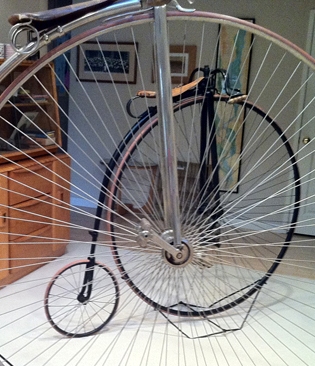 1886
Columbia
Roadster 1886
Columbia
Roadster
High-wheel bicycles were made in different sizes like ready-made trousers: too small and the rider's legs become jammed under the handlebars; too large and the rider cannot reach the pedals. If there were a 'standard' size, it might have been the 52-inch machine shown here through the spokes of the 64-inch Kinzli Bicycle. The Bicycle History Museum displayed these two high-wheel bicycles side by side, the smaller companion serving to provide a comparison. When acquired by Paul Niquette in 1978
the 1886 Columbia Roadster was in a deteriorated
condition, later restored by skilled craftsmen using
'space-age materials' expertly concealed. |
One of the earliest high-wheel bicycles, with many unusual features, including radial spokes with locking nuts at the hub, a brake operated by rotating the handle-bar, not seen on any other bicycle. This machine was first seen by Paul Niquette being used as a wall decoration hanging high up and out of reach at a Broadway Department Store in Los Angeles. Following a one-year negotiation with the management, which included purchasing a replacement wooden sculpture of a bicycle (from an antique dealer in Hayes, Kansas) and paying for the redecoration of the whole department. The nickname, "Penny Farthing" was regarded by high-wheelers as something of a pejorative -- tantamount to calling the early Ford motor cars "Tin Lizzies." |
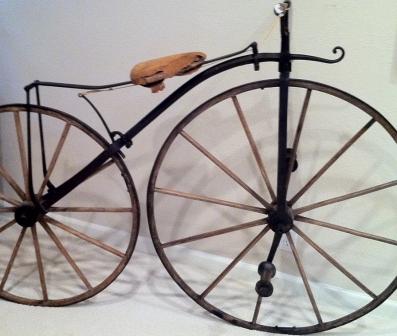 1861
Velocipede 1861
Velocipede "Fast Foot" One of the oldest pedal bicycle in America. Hand made, with no interchangeable parts -- a bicycle invention that came along 20 years later. The wagon-like wheels have staggered spokes, a wooden 'fello', and metal 'tyre'. Features include a vestigial horse's
head, the 'spool' pedal, staggered 'compression'
spokes, remotely controlled brake operated by a
leather thong wrapped around the handlebar.
A 'pendulum' keeps the flat part of the pedal on top (the idea of making the pedal flat on both sides had not yet been conceived, apparently), the candle lantern with a spring-loaded pantograph, a 'user-unfriendly' saddle, beaten from a plowshare. The word "velocipede" dates back to 1819, "wheeled vehicle propelled by the feet on the ground," from French vélocipède, from Latin velox "swift" + pedem "foot." |
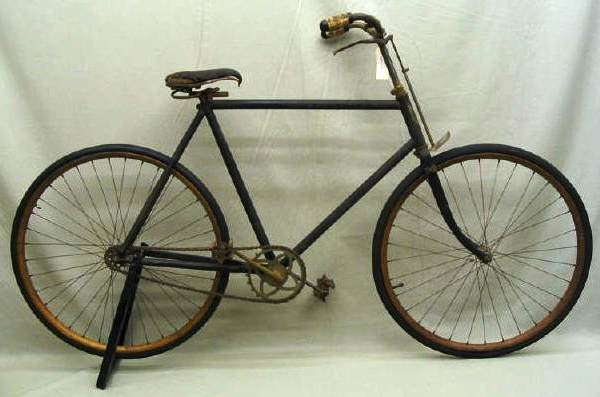 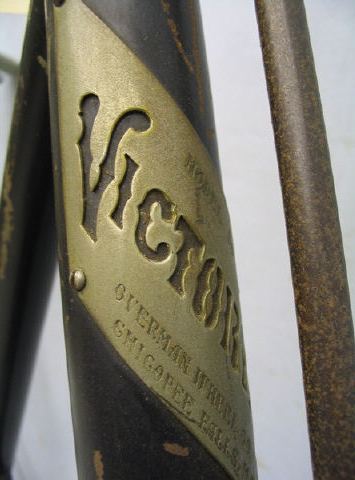 1890 Victoria Ladies Safety One of the earliest pneumatic tyred bicycles, this one having a brake on the front wheel.
|
| 1890 Barnes Special Racing Safety
Unusual decale head marker. Note the "hygienic saddle" -- but not brakes.
1890s Mens and Ladies Chainless Bevel gears, with shaft drive hidden inside the frame.
The source of awe for ladies -- all
ladies!
|
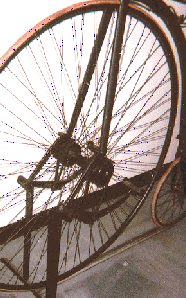 These two machine must be the most complex
bicycles ever built. These two machine must be the most complex
bicycles ever built.
|
|
Here is source of amusement and astonishment -- and not a little exercise: a pedal-less bicycle that resembles a scooter, yet the rider's feet do not contact the ground. Propulsion is by means of an eccentric rear wheel, which causes the platform to undulate over the ground. The rider "gets into the swing of it," so to speak maintaining synchrony and keeping the machine in motion along the parade route.
|
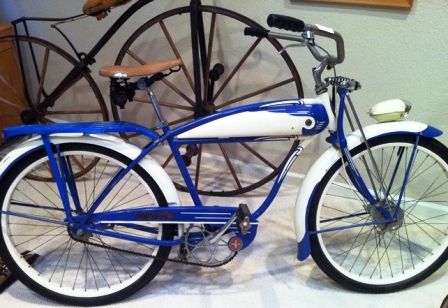 1950 Schwinn 1950 Schwinn
Only a barren soul would not be captivated by this classic |
|
1978 Ultrabike
|
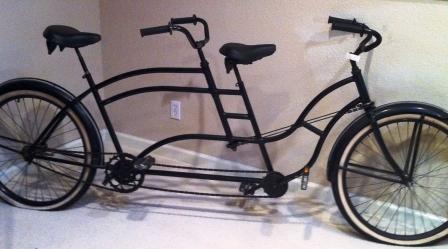 1935 Rear-Steering
Tandem 1935 Rear-Steering
Tandem The most civilized way for two people to go riding together. This bike has a special history. The collection includes a picture of the Paul Niquette riding it in 1941 sitting between his father in back and his mother in front. The machine has been featured in many parades. |
|
'Sail Bike' Probably the only one in existence. This machine operates much like a wind-surfer and would make a dazzling picture on a sunny day in a stiff breeze. Shown here with a standard 31 square foot sail. A custom 46 square foot sail comes with this machine. The Aerocycle will reach 2.5 times wind speed on a broad reach. |
| Homepage | Bicycle Pictures | Query |